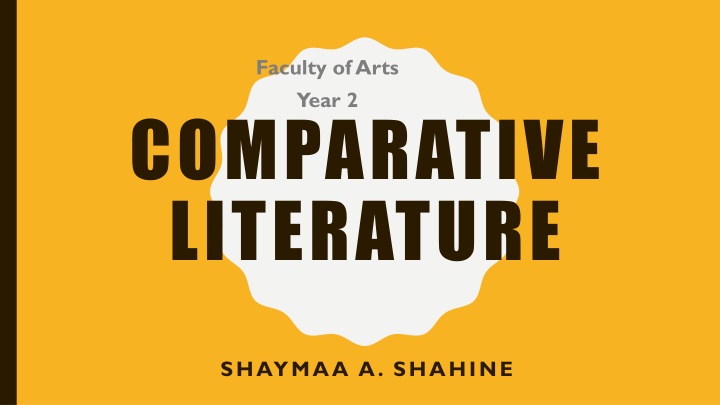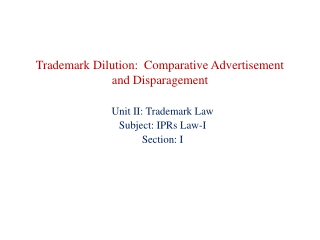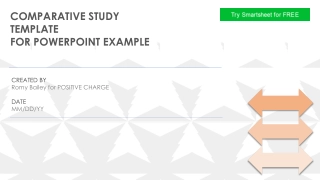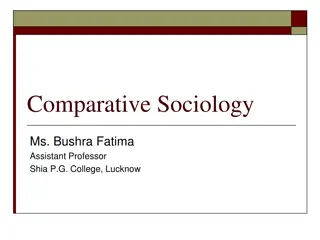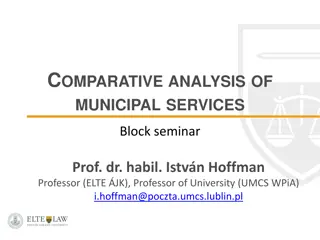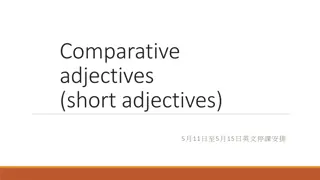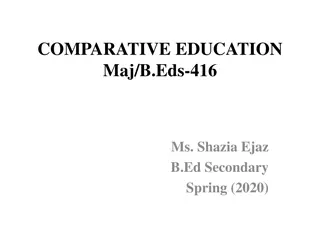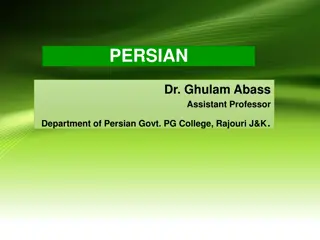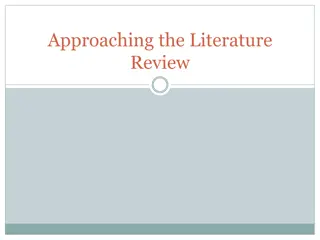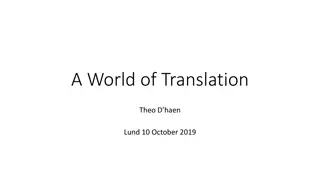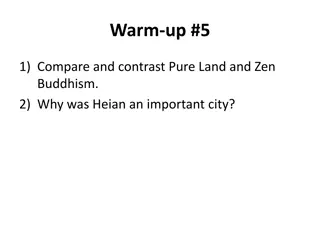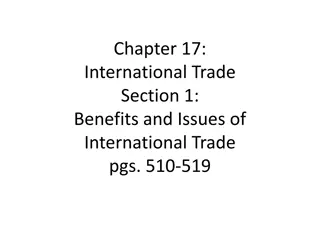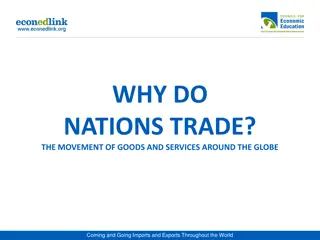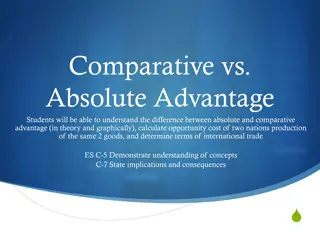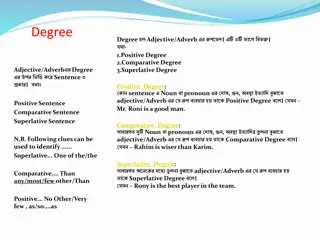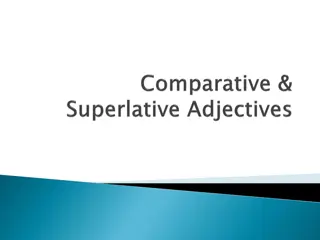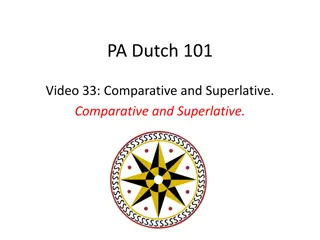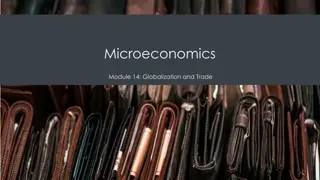Exploring Comparative Literature: Influence and Evolution
In the study of Comparative Literature, various schools of thought emphasize the influence between texts and the evolution of ideas. From the French school's focus on influence to the German school's idea of universal structure, different perspectives shape the understanding of literary connections and human experience. The American school further delves into the psychological aspects of literature, linking it to social and individual evolution. Through themes like intertextuality and parallelism, the field explores the complex relationships between texts and cultures.
Download Presentation

Please find below an Image/Link to download the presentation.
The content on the website is provided AS IS for your information and personal use only. It may not be sold, licensed, or shared on other websites without obtaining consent from the author.If you encounter any issues during the download, it is possible that the publisher has removed the file from their server.
You are allowed to download the files provided on this website for personal or commercial use, subject to the condition that they are used lawfully. All files are the property of their respective owners.
The content on the website is provided AS IS for your information and personal use only. It may not be sold, licensed, or shared on other websites without obtaining consent from the author.
E N D
Presentation Transcript
Faculty of Arts Year 2 COMPARATIVE LITERATURE SHAYMAA A. SHAHINE
CODES OF CONDUCT Phones are not allowed Start 10.30 to 12 p.m. Doors closes 10.40 Inside CLASS, you are allowed to drink water, eat what you have, go to Toilet, go out to use your phone (PLEASE DON T CAUSE DISTURBANCE) What is in it for you? Listening, Reading and Critical thinking Volunteers for Reflection Tree Volunteers for Question Bank
RETROSPECTIVE VIEW French school: Emphasizes the influence rather than aspects of Text itself in the strictest sense Trace History of comparative literature (Direct and Indirect Influence) Trace history of literary movements (passive and negative Influence) Influence: is simply the movement of an idea, a theme, an image, a literary tradition, or even a tone from a literary text into another. Source (politicalization) Originality (Nationality) Translation (two or more different languages) Khaled Hosseini Kite Runner / Adaptation: Harry Potter movies and fiction/ Women from Venice and Men from Mars External problems
TYPES OF INFLUENCE LITERARY & NON-LITERARY DIRECT & INDIRECT Shaw s Pygmalion Actual contact between writers: Al-Hakim s Pygmalion Shaw and AlHakim Harry Potter and European Mythology Darwin s Evolution of Species No contact Planet of Apes Shakespear s plays are derived from older texts Game of Thrones is derived from older texts Harry Potter is derived from everything e,g, Serpent s eyes , Mowgli, and Peter Pan
TYPES OF INFLUENCE POSITIVE AND NEGATIVE Shakespeare s Anthony and Cleopatra, Shaw s Caesar and Cleopatra resulted in Shawkqi s Cleapatra
RETROSPECTIVE VIEW German school: Emphasizes the creation of a universal structure of oneness. Evolvement of Ideas as the product of Human American school: (Ren Wellek and Henry H. H. Remak) Veselovsky: linked different literatures as a sign of resemblance in HUMAN PSYCHOLOGY H. Macaulay Posnett: linked literature to Social Evolution, Individual Evolution, and environment Mathew Arnold: Everywhere there is connexion, everywhere there is illustration: no single event, no single literature, is adequately comprehended except in its relation to other events, to other literatures. Wellek Criticism", "History of the Literature", "National Literature" and "General Literature" together. Science (Remak: founding father) Thematic evolving: Human experience is a LINGUISTIC RAW MATERIAL evolves in a NETWORK of texts Intertextuality e.g. Shaw s Pygmalion embeds Ovid s Myth, Planet of Ape embeds Darwin s Theory Parallelism e.g. DEPOLITICALIZATION of Comparative study Translations
AMERICAN SCHOOL PARALLEL INTERTEXTUALITY There is a HARMONY in process of developing LITERATURE, REGARDLESS of influence or mutual relation. There is HARMONY= TEXTS are NETWORK TEXTS are embedded directly or indirectly in TARGET text Similarities in human s SOCIAL Evolution Similarities in human s HISTORICAL Evolution ORIGINAL: HYPOTEXT TARGET: INTERTEXT SIMILARITIES= COMMON FEATURES TOO VAST TO INVESTIGATE = PHENOMENON WITH SPECIFIC PATTERN TOO VAST TO INVESTIGATE
William Words Worth Second language acquisition Kite Runner by Khaled Hosseini Quraan Pygmalion By Bernard Shaw Post colonial age Darwin s theory Planet of Apes TESOL Wide borders almost not defined Bible Managerial quality MBA Don Juan Stonning of Soraya A Thousand Splendid Suns by Khaled Hosseini USA Wars Old Testament
Critical Methodology is necessary to find similarities and differences Objects of comparison Thematic(quantity or quality) (Ideas/ Characters/ authors/ nationalities) Technical (quantity or quality):Language/figures of speech Example ??? Influence Parallel Intertextuality Similarities and differences are explained according to 1or 2 or 3 Criteria (Thematic/Technical)accordi ng to which objects are compared Quantity: With regard to repetition Quality: With regard to LOVE, LUST, Married LIFE, Tragedy, Comedy, Real vs Ideal
AMERICAN(INTERTEXUALITY/ PARRALLEL) FRENCH(INFLUENCE) The movement of Image with variations due to cultural differences (Link) 1- literary Genre and School Example: 2- Ideological Echoes: IDEAS Religion/philosophy/history Image of Sea in European poetry/drama 3- Images Echoes: (A Country s Image/An Image of a certain object or Charater in this country) Image of Desert in Arabic poetry Image of Trees in Indigious American Indian poetry 4-Verbal Echoes American School created INTERDISPLINARY ART with no consider for NATION, LINGUISTIC, POLITICS 5-Human Models and Heroes: ARCHETYPE same Image from one literary work (Source Text) to other texts Parallel: is to trace a certain characteristic in two different works beyond consistency, deviation, or origin. Example: Satan s image in Paradise Lost Intertextuality: texts are embedded directly or indirectly in target texts Lucifier s image in Doctor Faust
FRENCH AMERICAN Lack methods Varying methods Because it imposes binary studies No definite boarders Lack terminology Intertextuality Indirect Influence is controversial Parallelism Because ideas are echoed in most world literatures For example: Plato s Republic and Marx s communism are countlessly repeated One Thousand Night and a Night Mythology
WRAP QUESTIONS Is a comparatists sole aim to establish links between two or more literary works? What is a comparative methodology? Which methodology do you prefer? Why? What do you consider with each methodology?
COMPARING AND CONTRASTING Similarities should therefore not be allowed to obscure differences a certain type of measure can not be applied to all of the proposed, certain qualities are differently perceived by different people.
REFERENCES Elmas Sahin. On Comparative Literature. International Journal of Literature and Arts. Special Issue: World Literature, Comparative Literature and (Comparative) Cultural Studies. Vol. 4, No. 1-1, 2016, pp. 5-12. doi: 10.11648/j.ijla.s.2016040101.12 Haun Saussy, Comparative Literature? , PMLA 2003, 118(2): 336-41 (336, 340). xl Bernheimer, Comparative Literature in the Age of Multiculturalism, p. 12. Ferris, David, Indiscipline , in Comparative Literature in the Age of Globalization, edited by Haun Saussy (Baltimore: Johns Hopkins University Press, 2006), pp. 78-99 (p. 91). R. A. Jelliffe, An Experiment in Comparative Literature , College English 9 (1947) 2: 85-87 (p. 86). Steiner, George, What Is Comparative Literature? , Comparative Criticism, 18 (1996), 157-71 (p. 436). Ren Wellek, The Crisis of Comparative Literature , in Concepts of Criticism, edited by Stephen G. Nichols (New Haven & London: Yale University Press, 1963), pp. 282-295 (p. 290).
